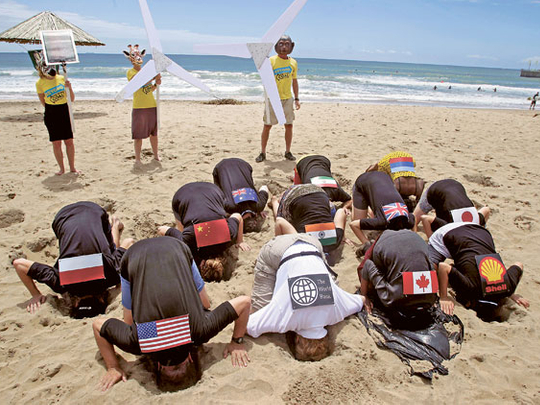
Durban: Brighten clouds with sea water? Spray aerosols high in the stratosphere? Paint roofs white and plant light-coloured crops? How about positioning "sun shades" over the Earth?
At a time of deep concern over global warming, a group of scientists, philosophers and legal scholars examined whether human intervention could artificially cool the Earth — and what would happen if it did.
A report released late on Thursday in London and discussed yesterday at the UN climate conference in South Africa said that — in theory — reflecting a small amount of sunlight back into space before it strikes the Earth's surface would have an immediate and dramatic effect. Within a few years, global temperatures would return to levels of 250 years ago, before the industrial revolution began dumping carbon dioxide into the air, trapping heat and causing temperatures to rise.
Side effects
But no one knows what the side effects would be.
They could be physical - unintentionally changing weather patterns and rainfall. Even more difficult, it could be political — spurring conflict among nations unable to agree on how such intervention, or geoengineering, will be controlled.
The idea of solar radiation management "has the potential to be either very useful or very harmful," said the study led by Britain's Royal Society, the Washington-based Environmental Defence Fund and TWAS, the academy of sciences for the developing world based in Trieste, Italy.
The final report grew out of three days of talks in a quiet country retreat last March, the climax of a yearlong dialogue spanning experts in 22 countries. It was prompted in part by the failure of a 20-year UN negotiating process to take decisive action to curb greenhouse gas emissions, mainly from burning fossil fuels, responsible for climate change.
"The slow progress of international climate negotiations has led to increased concerns that sufficient cuts in greenhouse gas emissions may not be achieved in time to avoid unacceptable levels of climate change," the report said. But geoengineering is not an alternative to climate action, said John Shepherd, a British oceanographer from the University of Southampton who was a lead author of the report.
"Nobody thought this provides a justification for not reducing carbon emissions," Shepherd said in a telephone interview from London.
"We have to stick with Plan A for the time being, and that could be a very long time indeed," he said. "This would buy time for people to make the transition to a low-carbon economy."
The Intergovernmental Panel on Climate Change foresees temperatures rising as much as 6.4C by 2100, swelling the seas with melted glacial water and disrupting climate conditions around the globe.
Releasing millions of tons of sulfur dioxide in the upper atmosphere would mimic the cooling effects of a volcanic eruption, lowering global temperature about 0.5C, which can last for a year or two when it occurs naturally.
Stop-gap measure
But deliberately tinkering with nature to counter global warming can only be a stop-gap measure, and is fraught with danger, the report said.
Action such as spraying sulfur into the air or brightening clouds with sea water to reflect more sunlight would have to be sustained indefinitely because "there would be a large and rapid climate change if it were terminated suddenly," the report said.
Hazy skies could alter weather patterns and agriculture, replacing one source of climate change with another.












